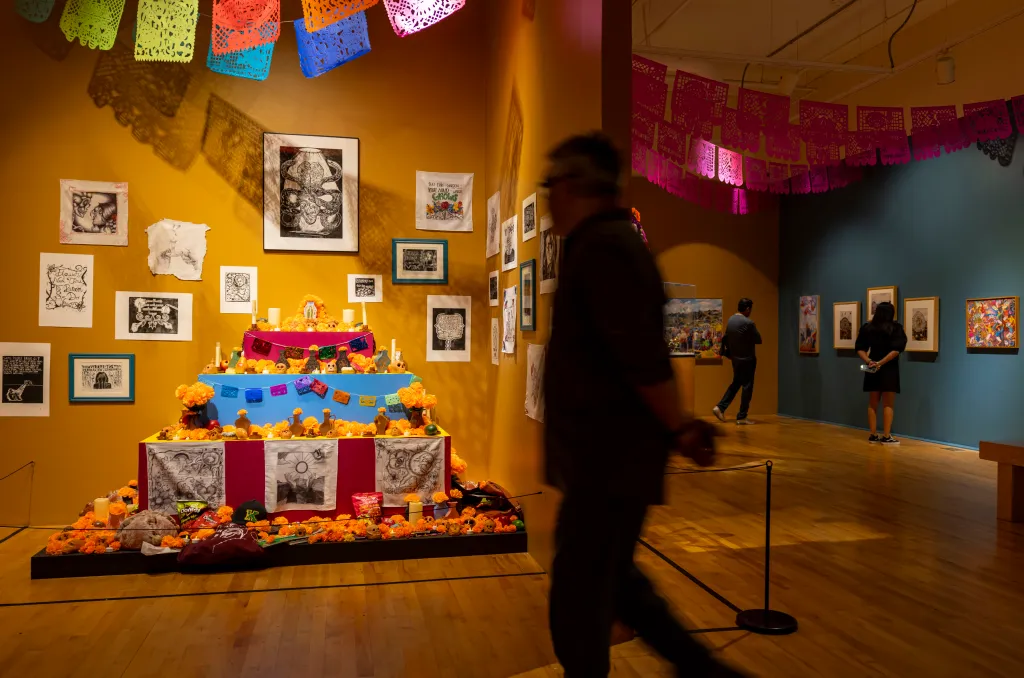
With tensions high in the Pilsen neighborhood amid immigration crackdowns, art is offering a way for community members to unite and celebrate Mexican culture.
The National Museum of Mexican Art opened its 39th annual exhibition of “Día de Muertos: A Celebration of Remembrance” on Sept. 19. Rooted deep in Mexican heritage, the Day of the Dead (observed Nov. 1-2) honors loved ones who have passed away.
There are many beliefs about what happens when someone dies, and different artists captured their own ideologies in their artwork.
Attendance was scarce at the annual Pilsen Mexican Independence Day parade last month and Elisa Soto Sánchez, the museum’s curatorial and exhibitions associate, was expecting the same at the new show, but hasn’t seen much of a difference.
On opening night, the museum was crowded, Sánchez said, as about 700 people attended the exhibit.
Museum visitors’ introduction to “Dia De Muertos” is a colorful Túmulo, a wooden structure usually seen in churches during funerals.
A piece by the Ramírez Casteñada family displayed historical Mexican skeleton figures from Chicago protesting in Little Village with signs written in Spanish.
The creators — Miriam and Martín, and their daughter Regina — are based in Mexico and were commissioned by the museum to make the piece. Museum workers provided the family with information for the figures depicted in the display.
The objective was to create something that memorialized the dead, Regina Ramírez Casteñada said, and after meeting with some of the museum staff members, they all came to the conclusion that the piece should be about a protest.
“We were very into it because we share that feeling of fight and resistance of our Latin brothers and sisters on the other side of the border,” Miriam Ramírez Casteñada said in Spanish as her daughter translated during an interview with the Tribune. “We feel identified with them, we see the news and that was our little grain of sand in that feeling of resistance.
“It’s important not to keep quiet before injustice,” Miriam Ramírez Casteñada said. “We should not be afraid to express what makes us feel bad.”
Martín Ramírez Casteñada said he and his family hear about the situation from their relatives in the U.S. who are being impacted. For him, it was important to give something back.
Making the piece to celebrate the holiday was meaningful, the family said. The celebration of life is one of the most important traditions for Mexicans, and Miriam Ramírez Casteñada said she feels it on a spiritual level.
Museumgoer Lisa Odom, 61, said the Ramírez Casteñada family’s art is “very essential to what’s going on now.”
Odom, a retired military officer, said she is enraged by what’s happening around the country.
“To see what I spent 30 years of my life in service to be destroyed, it’s upsetting beyond belief to watch this systematic racism (and) the destruction of democracy,” Odom said.
Art comes as an outlet for expression when trying to get out emotions, Odom said. “Whenever we don’t have a voice, you can always turn to art,” she said.
Daniela Portales, another museumgoer, said the Ramírez Castañeda family piece “hit close to home.”
“My mom, she’s an immigrant; she’s at home,” Portales said. “She doesn’t want to go out, so it’s heartbreaking”
It was the first time the exhibit artists went to an unveiling.
“Considering everything that’s going on, it was great to see all these people come in,” Sánchez said.
The Day of the Dead is celebrated in many parts of the world, most notably in Mexico and Central America.
Although death can be a taboo topic, Sánchez said the staff at the museum took a different approach when setting up the installation, dedicating one of its exhibit rooms to humorous art.
Vibrant pieces of Cartonería, or paper-mache, created by Ricardo Linares García, feature skeletons engaged in exaggerated activities, such as taking down a big blue monster, cooking stew or fighting the devil while climbing trees.
Other pieces around the museum feature artists’ loved ones and memorabilia. Many pieces contain skeletons that represent the mix of life and death.
As guests leave the exhibit, Sanches said, they are met with the sight of a family gathered at a cemetery at night, spending time with their loved ones.



